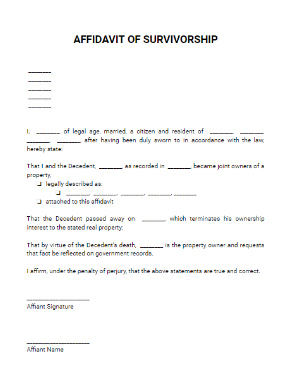- Eviction Notice Forms
- Power of Attorney Forms Forms
- Bill of Sale (Purchase Agreement) Forms
- Lease Agreement Forms
- Rental Application Forms
- Living Will Forms Forms
- Recommendation Letters Forms
- Resignation Letters Forms
- Release of Liability Agreement Forms
- Promissory Note Forms
- LLC Operating Agreement Forms
- Deed of Sale Forms
- Consent Form Forms
- Support Affidavit Forms
- Paternity Affidavit Forms
- Marital Affidavit Forms
- Financial Affidavit Forms
- Residential Affidavit Forms
- Affidavit of Identity Forms
- Affidavit of Title Forms
- Employment Affidavit Forms
- Affidavit of Loss Forms
- Gift Affidavit Forms
- Small Estate Affidavit Forms
- Service Affidavit Forms
- Heirship Affidavit Forms
- Survivorship Affidavit Forms
- Desistance Affidavit Forms
- Discrepancy Affidavit Forms
- Guardianship Affidavit Forms
- Undertaking Affidavit Forms
- General Affidavit Forms
- Affidavit of Death Forms
Survivorship Affidavit
Owning a property with one or more people can often put those involved in a tough situation, especially upon the death of one of the owners. The surviving owner(s) would then need to invoke their legal rights and take ownership of the property for further estate planning. But there’s a legal process and paperwork to sort out before establishing any transfers and ownership changes, and that’s when a Survivorship Affidavit becomes a useful tool for the concerned parties. Read More

By Type
Survivorship Affidavit
What Is a Survivorship Affidavit?
A Survivorship Affidavit is a legal document that allows current or surviving property parties to claim real or personal property of the deceased and remove the decedent’s name as owner. Although joint property owners can have the necessary documentation prepared in anticipation of someone’s untimely passing, it’s more common for people to file the Affidavit of Survivorship following one’s death.
How to Create a Survivorship Affidavit
State laws have varying guidelines on how to deal with joint tenancy or property ownership after one of the original owners dies. Apart from a death certificate, a survivorship affidavit can also play a role in declaring a surviving party’s right to inherit the decedent’s property share following the latter’s death. Fortunately, any competent individual can easily draft this document even without hiring a lawyer. Below are four simple tips to remember when writing an affidavit of survivorship.
Gather the required information
There are certain details regarding the right of survivorship that need to reflect on the affidavit. Some of the data you’d want to include are the full names of the current owners and the legal description of the property. If you have any difficulty identifying this information, you can have things clarified at your local Assessor’s Office for full disclosure. The property deed in file will also answer some of your questions, so be sure to have these documents ready.
Introduce the parties concerned
The affidavit must contain sufficient identification details of all property owners, including the decedent’s name, birth and death date, and last place of residence. The name, age, and residential address of the surviving parties must also be stated in the document. In some cases, you might also want to indicate each surviving party’s relationship to the decedent, especially if the individual does not have the same surname as the deceased.
Verify all facts and include a statement of truth
Conclude the affidavit by attesting to the truthfulness of all information enclosed in the document. Before signing, you need to make sure that all details remain true and correct to the best of your knowledge. It’s also important to review spellings and other critical information that may cause disputes if not properly defined in the affidavit.
Notarize the affidavit and attach any supporting documents
Once your draft is complete, you can have it notarized by a notary public to verify your identity. Laws affecting real estate are different in every state. While the deceased co-owner’s death certificate might suffice in some states, others would require the surviving co-owner to file a survivorship affidavit to present the facts surrounding the proposed transfer of ownership and title. Banks and other financial institutions may follow the same protocol, so it won’t hurt to have these documents prepared beforehand.
FAQs
Does a right of survivorship override a will?
A right of survivorship takes precedence over any other terms in a last will and testament. That’s because properties with a right of survivorship do not go through probate nor do they become part of a decedent’s estate, which means the property in question is not subject to a will. It can be a complicated matter to deal with when navigating through ownership and estate planning, which is why the assistance of an estate law attorney is a must.
Can a right of survivorship be challenged?
Errors in documentation and terms not accurately defined in a survivorship clause or affidavit may be disputed by providing sufficient evidence to challenge the right of survivorship. However, securing enough proof to contest this right can be very difficult, especially if it prevails over other contracts that attempt to contradict the right. In such circumstances, you’ll need to consult the appropriate persons and agencies for further legal assistance.
What happens when the last surviving owner dies?
If the last surviving owner—who was once subject to survivorship rights—passes away, the property may be included in their estate for distribution among the decedent’s heirs. The survivorship rights that once existed will no longer prevail since there are no survivors left to claim ownership of the property. This circumstance is something that joint owners must consider when coming to an agreement and creating their respective wills.
When do I need a survivorship affidavit?
There are two scenarios that will compel you to draft a survivorship affidavit: before the unfortunate happens and after someone dies. There are several complications that come with owning a joint property, and there’s often a lot at stake for either parties. So if you own a joint property and want to prepare for the worse, securing the right documentation is always a wise move. But if you didn’t have the chance to get the right paperworks ready beforehand, you can still restate the transfer of property interest using the affidavit.
What is the difference between joint tenants and tenants in common?
Knowing the two principle types of multiple property ownership can help you determine whether you have a right of survivorship to a property or not. For joint tenants, the parties share equal rights to the property and are entitled to survivorship rights. When one party dies, the property interest of the decedent automatically transfers to the surviving owner(s). On the contrary, tenants in common typically possess different ownership interests with no survivorship rights. Unless the decedent specifically grants the distribution of property interests among the surviving owner(s), the said property interests goes to the decedent’s estate.
Keep in mind that there are legal and financial consequences that can come as a result of transferring real or personal property. While filing an affidavit is a quick and easy process, seeking assistance from an accountant, financial advisor, or estate lawyer may be necessary when facing complicated situations.
